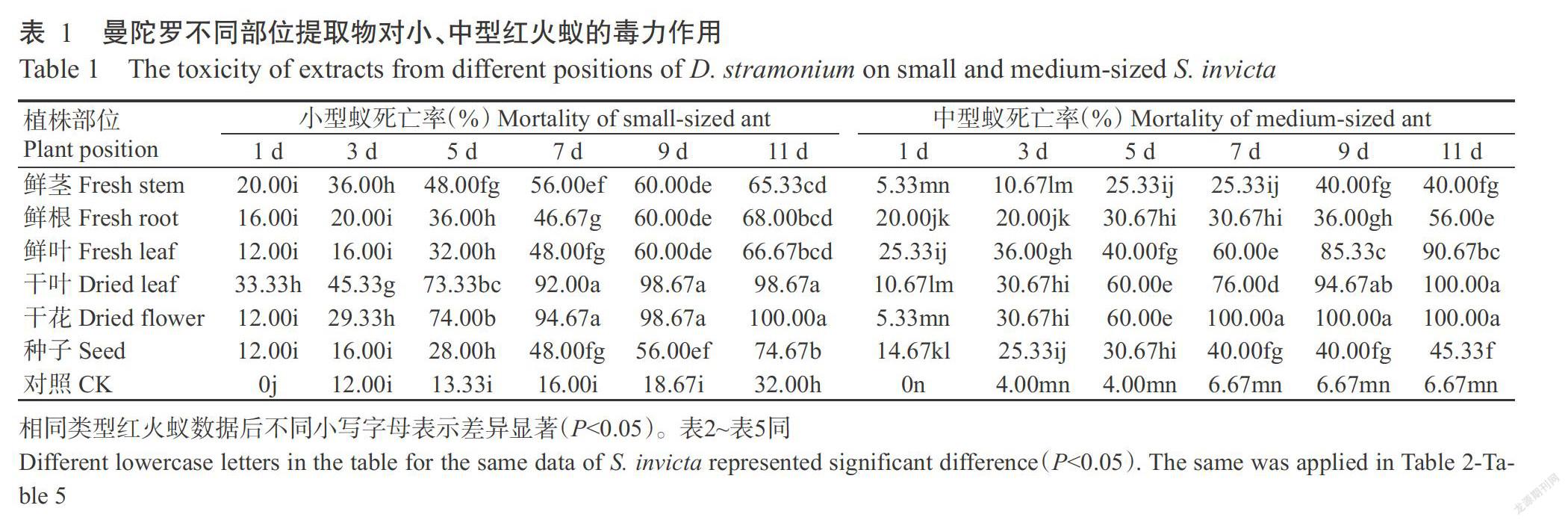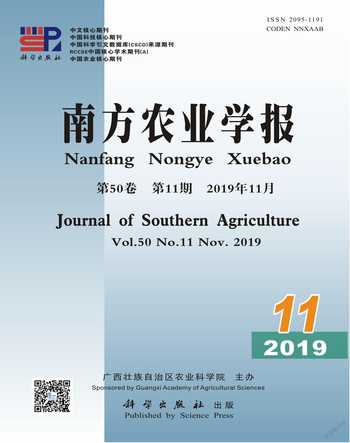曼陀罗不同部位提取物对红火蚁的作用
杨静美 张志祥 叶滔 蔡奕浩 陈趣 王文凯



摘要:【目的】研究曼陀羅不同部位提取物对小、中型红火蚁工蚁的毒杀活性及行为作用,为利用植物源药剂防治红火蚁及其他有害生物提供科学依据。【方法】采用水试管喂养法,探究曼陀罗根、茎、叶、花和种子提取物对红火蚁的毒力及攀爬率、抓附率、行走率和聚集率等行为的影响。【结果】曼陀罗不同部位提取物对小、中型红火蚁均具有一定的毒力,且随处理时间的延长红火蚁死亡率上升,其中以曼陀罗干叶和干花对两种蚁型红火蚁的毒杀效果最好,处理11 d后,干叶和干花提取物处理小型蚁的死亡率分别为98.67%和100.00%、中型蚁的死亡率均为100.00%。曼陀罗不同部位提取物对红火蚁的抓附率、攀爬率、聚集率和行走率等行为也具有抑制作用,其中以曼陀罗干花和干叶的作用效果最好,处理11 d后,干花提取物处理两种蚁型红火蚁的攀爬率、抓附率、聚集率和行走率均为0;干叶提取物处理小型蚁的攀爬率、抓附率和行走率均为1.33%、聚集率为0,而中型蚁的攀爬率、抓附率、行走率和聚集率均为0。【结论】曼陀罗不同部位提取物对两种蚁型红火蚁均具有良好的毒杀活性,对其行为有一定的抑制作用,其中以干花的影响力最明显,具有开发成新型绿色环保红火蚁防治植物材料的潜力。
关键词: 红火蚁;曼陀罗;毒杀活性;行为抑制作用
中图分类号: S433; S759.82 文献标志码: A 文章编号:2095-1191(2019)11-2475-06
Effects of different parts of Datura stramonium on the
Solenopsis invicta Buren workers
YANG Jing-mei1,2, ZHANG Zhi-xiang3*, YE Tao4, CAI Yi-hao2,
CHEN Qu2, WANG Wen-kai1*
(1College of Agriculture, Yangtze University, Jingzhou, Hubei 434025, China; 2College of Agriculture and Biology, Zhongkai University of Agriculture and Engineering, Guangzhou 510225, China; 3College of Agriculture, South China Agricultural University/Key Laboratory of Natural Pesticide and Chemical Biology, Ministry of Education, Guangzhou 510642, China; 4School of Pharmaceutical Sciences, Guangzhou Medical University, Guangzhou 511436, China)
Abstract:【Objective】The insecticidal activity and the behavior of medium and small-sized workers of red imported fire ants were studied with Datura stramonium extracts, providing the basis for the control of red imported fire ants and other pest by botanical insecticides. 【Method】The effects of extracts from root, stem, leaf, flower and seeds of D. stramonium on the toxicity, climbing rate, grasping rate, walking rate and aggregation rate of red fire ants were studied by aqueous solution tubes method. 【Result】Extracts from different parts of D. stramonium had toxicity to both small and medium-sized red imported fire ants, and the mortality of red imported fire ants increased with time. Among them, dried leaves and dried flowers of D. stramonium had the best toxicity on the two types of red imported fire ants. After 11 d, the mortality of small ants treated with dried leaves and flowers were 98.67% and 100.00%, respectively, and the mortality of medium ants were both 100.00%. Extracts from different parts of D. stramonium also had inhibitory effects on the grasping rate, climbing rate, aggregation rate and walking rate of red imported fire ants, the effects of dried flowers and leaves were the best. After 11 d, the climbing rate, grasping rate, aggregation rate and walking rate treated with dried flower extracts for the two ant types were all 0. The climbing rate, grasping rate and walking rate of small ants treated by dried leaves were all 1.33%, and aggregation rate was 0, while the climbing rate, grasping rate, walking rate and aggregation rate of medium ants were 0 with dry leaves. 【Conclusion】All the parts of D. stramonium have insecticidal activity and behavioral inhibition effects on two types of the red imported fire ants, and dries flower has the optimal effects, may be the green environmental protection agent to control red imported fire ants.
Key words: Solenopsis invicta Buren; Datura stramonium; insecticidal activity; behavioral inhibition effect
0 引言
【研究意义】红火蚁(Solenopsis invicta Buren,red imported fire ant,RIFA)是世界上最严重的100种外来入侵物种之一,是一种营社会生活的昆虫,原产于南美洲,后迅速扩散到澳大利亚、新西兰、马来西亚、泰国和菲律宾等地(Zhang et al.,2007;赵瑾等,2009;Wang and Lu,2017)。我国于2004年首次发现红火蚁,后在南方多个省份发生危害,其对生态环境、人类、动植物及公共设施等造成了严重危害,甚至危及人类的生命(Ascunce et al.,2011;Tian et al.,2015;吳伟斌等,2017;王智楠等,2019)。目前红火蚁的防治方法多集中在化学、物理和生物方面,其中化学防治的效果最好,但化学防治给环境带来的潜在危害不容忽视,因此,寻求有效的绿色药剂是当前红火蚁防治的重要目标。【前人研究进展】红火蚁绿色药剂防治主要集中在运用植物源药剂和生物防治上。研究发现,多种植物源药剂对红火蚁具有一定的防治效果。Li等(2014)研究发现,非洲山毛豆豆荚和枝叶中的挥发性物质蒎烯等对红火蚁有一定的熏蒸毒力,作用1~12 h后小型红火蚁的死亡率分别为18.33%~100.00%和13.33%~100.00%。Zhang等(2014)的研究结果表明,青蒿油有较强的杀红火蚁活性,且在密闭环境中抑制作用更强。新鲜九里香叶、落叶和干叶提取物作用1~9 d后小型红火蚁的死亡率分别为5.00%~100.00%、11.67%~93.33%和15.00%~83.33%(Huang et al.,2016a);作用48 h后,新月蕨甲醇和乙酸乙酯提取物对大型红火蚁的LC50分别为524.0和145.9 μg/g,对小型红火蚁的LC50分别为321.9和90.0 μg/g(Huang et al.,2016b)。王磊等(2018)研究发现,1×108孢子/mL浓度的金龟子绿僵菌M09处理10 d后对红火蚁幼虫的侵染率为98.9%,蛹为100.0%,有较强的致病力,致死速度较快。白花曼陀罗(Datura metel Linn.)为茄科(Solanacea)曼陀罗属(Datura Linn.)植物,又名洋金花,分布广泛,内含莨菪碱和东莨菪碱等,是常见的中草药及杀虫植物(张宏利等,2004;陆秀红等,2006)。研究发现,白花曼陀罗种子提取液对线虫有较好的毒杀作用(Goswami and Vijayalakshmi,1987;Gamal et al.,2008);曼陀罗叶、籽提取物对立枯丝核菌菌丝、甘蓝蚜虫和朱砂叶螨等均具有良好的生物活性(杨文,2006)。【本研究切入点】基于植物源药剂对红火蚁的研究已有较多报道,但曼陀罗对红火蚁的作用研究鲜见报道。【拟解决的关键问题】以白花曼陀罗植物为材料,通过研钵研磨,超声波振动提取其根、茎、叶、花和种子中的有毒物质,采用水试管喂毒法,探究各提取物对小、中型红火蚁工蚁的毒力及行走率、抓附率、攀爬率和聚集率等行为的影响,为利用植物源药剂防治红火蚁及其他有害生物提供科学依据。
1 材料与方法
1. 1 试验材料
1. 1. 1 供试植物材料 白花曼陀罗,产自江苏徐州。
1. 1. 2 供试红火蚁工蚁 红火蚁(S. invicta)工蚁来源于华南农业大学附近农场。小型蚁头宽0.6~0.7 mm,中型蚁头宽0.7~0.9 mm。将红火蚁工蚁连巢穴装入桶壁有滑石粉的塑料桶中,室内养殖(温度25~28 ℃,湿度70%~80%,光照∶黑暗=12 h∶12 h,桶中放入水试管、火腿肠饲养)1周后待用。
1. 2 试验方法
1. 2. 1 曼陀罗各部位有效成分提取 分别将曼陀罗的鲜根、鲜茎、鲜叶、干叶、干花和种子加入适量乙醇和蒸馏水充分研磨,超声波1 h后放入烘箱中50 ℃下烘干(尚天翠,2016)。取出后各加入适量乙醇和蒸馏水搅拌振荡,得到浓度分别为鲜茎1.5 g/45 mL和1.5 g/30 mL、鲜根1.0 g/40 mL、鲜叶1.5 g/45 mL和1.5 g/30 mL、干叶1.5 g/90 mL和1.5 g/75 mL、干花1.5 g/90 mL和1.5 g/75 mL、种子1.5 g/45 mL和1.5 g/30 mL的溶液。对照组仅在蒸馏水中加入乙醇。试验组和对照组均将乙醇挥发至无气味。
1. 2. 2 曼陀罗各部位提取物对红火蚁的毒杀活性测定 采用试管中加入溶液,管口塞入棉花致溶液缓慢渗出的方式喂养红火蚁,并进行毒力测定(Zhang et al.,2017)。将不同部位的曼陀罗溶液(小型蚁:鲜茎1.5 g/45 mL、鲜根1.0 g/40 mL、鲜叶1.5 g/45 mL、干叶1.5 g/90 mL、干花1.5 g/90 mL、种子1.5 g/45 mL;中型蚁:鲜茎1.5 g/30 mL、鲜根1.0 g/40 mL、鲜叶1.5 g/30 mL、干叶1.5 g/75 mL、干花1.5 g/75 mL、种子1.5 g/30 mL)依次加入2 mL试管中,试管口塞入棉花后放入塑料杯中,杯口以下1~2 cm处涂抹滑石粉。在每个塑料杯中接入25只红火蚁,每处理重复3次,对照则在试管中加入蒸馏水。每个塑料杯中放入少许火腿肠喂食红火蚁,下同。喂食1、3、5、7、9和11 d后,观察曼陀罗不同部位提取液及浓度下红火蚁的死亡情况。根据公式计算红火蚁死亡率平均值:死亡率(%)=死亡工蚁数/总工蚁数×100。
1. 2. 3 曼陀罗各部位提取物对红火蚁抓附率、攀爬率、聚集率和行走率的影响 按照1.2.2的方法,观察杯中红火蚁的行为。攀爬率测定:将竹签从底部开始每隔1 cm处标记,轻轻碰触杯中的红火蚁至竹签上,其在竹签上攀爬的距离超过3 cm时,认为红火蚁具有攀爬能力(Zhang et al.,2013);计算攀爬率:攀爬率(%)=有攀爬能力的工蚁数/总工蚁数×100。抓附率测定:轻轻振动塑料杯,待红火蚁分布在杯底静置10 s后,将白纸紧贴于杯口,待杯子翻转180°后,停顿5 s,随后翻转杯子至原来位置,观察杯中余下的红火蚁数量,掉落在杯中的红火蚁即为不具有抓附能力的蚂蚁;计算抓附率:抓附率(%) =(总工蚁数-杯中工蚁数)/总工蚁数×100。聚集率测定:将塑料杯轻轻振动,待红火蚁在杯底静置10 s后观察红火蚁的聚集情况,3只及以上能聚集在一起即为有聚集能力;计算聚集率:聚集率(%)=聚集的工蚁数/总工蚁数×100。行走率测定:在A4白纸上打印多个1 cm×1 cm的小正方形,将红火蚁放到白纸上,若红火蚁3 s内能行走3 cm,则认为其具有行走能力;计算行走率:行走率(%)=具有行走能力的工蚁数/总工蚁数×100。
1. 3 统计分析
利用SAS 9.0对试验数据进行方差分析。
2 结果与分析
2. 1 曼陀罗对红火蚁的毒力作用测定结果
曼陀罗不同部位提取物对小、中型红火蚁的毒力测定结果(表1)显示,在不同曼陀罗部位提取物作用下红火蚁的死亡率均随处理时间的延长而上升,其中,曼陀罗干叶和干花对两种红火蚁工蚁的毒杀效果最好,处理11 d后,干叶和干花提取物处理小型蚁的死亡率分别为98.67%和100.00%,其他部位提取物处理小型蚁的死亡率为65.33%~74.67%,与对照(32.00%)相比均达显著差异水平(P<0.05,下同);干叶和干花提取物处理中型蚁的死亡率均为100.00%,其他部位提取物處理中型蚁的死亡率为40.00%~90.67%,与对照(6.67%)相比均达显著差异水平。
2. 2 曼陀罗对红火蚁攀爬率的影响
由表2可知,各处理组红火蚁在相同处理时间下均以对照的攀爬率最高,且均随处理时间的延长红火蚁攀爬率呈下降趋势,其中,曼陀罗干花和干叶对红火蚁的影响最大,处理11 d后,曼陀罗干花和干叶处理小型红火蚁的攀爬率分别为0和1.33%,其他部位提取物处理小型红火蚁的攀爬率为21.33%~32.00%,与对照(65.33%)相比均达显著差异水平;曼陀罗干花和干叶提取物处理中型红火蚁的攀爬率均为0,其他部位提取物处理中型红火蚁的攀爬率为8.00%~56.00%,与对照(89.33%)相比均达显著差异水平。
2. 3 曼陀罗对红火蚁抓附率的影响
由表3可知,各处理组红火蚁在相同处理时间下均以对照的抓附率最高,且均随处理时间的延长红火蚁抓附率逐渐下降,其中,曼陀罗干花和干叶对红火蚁的影响最大,处理11 d后,曼陀罗干花和干叶处理小型红火蚁的抓附率分别为0和1.33%,其他部位提取物处理小型红火蚁的抓附率为18.67%~29.33%,与对照(61.33%)相比均达显著差异水平;曼陀罗干花和干叶提取物处理中型红火蚁的抓附率均为0,其他部位提取物处理中型红火蚁的抓附率为6.67%~54.67%,与对照(88.00%)相比均达显著差异水平。
2. 4 曼陀罗对红火蚁聚集率的影响
由表4可知,各处理组红火蚁在相同处理时间下均以对照的聚集率最高,且均随处理时间的延长红火蚁聚集率呈下降趋势,其中,曼陀罗干花和干叶对小型红火蚁的影响最大,处理7 d后小型红火蚁的聚集率即降为0,其他部位提取物处理11 d后小型红火蚁的聚集率为14.67%~28.00%,且与对照(60.00%)间存在显著差异;曼陀罗干花、干叶和鲜叶提取物处理对中型红火蚁的影响最大,分别在处理7、11和11 d后红火蚁的聚集率降为0,其他部位提取物处理11 d后中型红火蚁的聚集率为17.33%~34.67%,且与对照(69.33%)间存在显著差异。
2. 5 曼陀罗对红火蚁行走率的影响
由表5可知,各处理组红火蚁在相同处理时间下均以对照的行走率最高,且均随处理时间的延长红火蚁行走率逐渐下降,其中,曼陀罗干花对小型红火蚁的影响最大,处理9 d后小型红火蚁的行走率即降为0,其他部位提取物处理11 d后小型红火蚁的行走率为1.33%~30.67%,且与对照(66.67%)相比达显著差异水平;对中型红火蚁行走率影响最大的是曼陀罗干花和干叶,分别于处理7和11 d后红火蚁的行走率降为0,其他部位提取物处理11 d后中型红火蚁的行走率为8.00%~58.67%,且与对照(90.67%)相比达显著差异水平。
3 讨论
曼陀罗是一种药用植物,全株有毒,已广泛应用于医学、农业和林业领域(Alberto et al.,2001)。印度当地的医生常用其提取物治疗各种炎症性疾病(Navaratnarajah et al.,2007);其对粘虫和蚜虫等多种农业害虫具有毒杀作用(李国平和杨鹭生,2002;孙洋等,2008)。在曼陀罗叶乙醇提取物作用下,菜青虫胃毒的死亡率可达92%,触杀死亡率为84.4%,拒食率为62.5%,表现出良好的杀虫作用(高红明等,1999)。曼陀罗种子能引起大鼠病理形态学改变(Verma et al.,2012),其东莨菪碱等对人体有极高的致幻作用。因此,以曼陀罗为植物材料来源,有望研发出有效的杀红火蚁药剂,但目前曼陀罗对红火蚁行为和毒力的研究较少见报道。
本研究结果表明,曼陀罗不同部位的乙醇提取物对红火蚁均有一定毒力,其中干花对两种红火蚁工蚁的毒杀效果最好,小、中型红火蚁分别在处理11和7 d后死亡率达100.00%;其次是干叶,处理11 d后小、中型红火蚁的死亡率分别为98.67%和100.00%,表现出较强的毒杀活性。曼陀罗不同部位提取物对红火蚁的抓附率、攀爬率、聚集率和行走率也有抑制作用,会影响整个蚁群的繁衍及活动,与刘娜等(2011)的研究报道一致。本研究显示,在曼陀罗干花作用下,处理11 d后两种蚁型的攀爬率、抓附率、聚集率和行走率均为0;在曼陀罗干叶作用下,处理11 d后小型红火蚁的攀爬率、抓附率和行走率均为1.33%,聚集率为0,而中型红火蚁的攀爬率、抓附率、行走率和聚集率均为0,干花和干叶对红火蚁均表现出良好的行为影响作用。本研究采用的乙醇提取法操作简单,且曼陀罗干叶和干花来源方便,具有一定的实际应用意义。
本研究仅探讨了曼陀罗不同部位提取物在室内条件下对小、中型红火蚁工蚁的毒力和行为作用,但在田间的效果如何,是否可采用其他提取杀虫物质的方式或拌饵料法、喷雾法等作用方式,是否可与其他植物源药剂混用增强作用效果均有待进一步研究证实。
4 结论
经曼陀罗各部位提取物作用后两种蚁型红火蚁的行为能力均有所降低,对减轻红火蚁的危害及对整个蚁群的防治均具有一定积极作用。曼陀罗各部位提取物中,干花对两种蚁型红火蚁的影响最明显,具有开发成新型绿色环保红火蚁防治植物材料的潜力。
参考文献:
高红明,王兆龙,张彪,吴晓霞. 1999. 植物提取液对菜青虫的杀虫活性研究[J]. 江苏农业研究,20(4): 32-34. [Gao H M,Wang Z L,Zhang B,Wu X X. 1999. Insecticidal activity of some plant extracts against Pieris rapae[J]. Jiangsu Agricultural Research,20(4):32-34.]
李国平,杨鹭生. 2002. 福建杀虫植物资源初步调查研究[J]. 亚热带植物科学,31(1):41-46. [Li G P,Yang L S. 2002. Preliminary investigation of insecticidal plant resource in Fujian Province[J]. Subtropical Plant Science,31(1): 41-46.]
劉娜,程东美,徐汉虹,张志祥. 2011. 光活化成分α-三联噻吩对红火蚁的致死作用及对其行为的影响[J]. 中国农业科学,44(23):4815-4822. [Liu N,Cheng D M,Xu H H,Zhang Z X. 2011. Behavioral and lethal effects of α-terthienyl on the red imported fire ant(RIFA)[J]. Scientia Agricultura Sinica,44(23): 4815-4822.]
陆秀红,刘志明,刘纪霜,黄金玲,潘萍红. 2006. 白花曼陀罗叶总碱提取物杀线活性及其作用机理研究[J]. 中国农学通报,22(12): 331-334. [Lu X H,Liu Z M,Liu J S,Huang J L,Pan P H. 2006. Nematicidal activities and mechanisms of total alkaloids extracts from leaf of Datura metel Linn[J]. Chinese Agricultural Science Bulletin,22(12): 331-334.]
尚天翠. 2016. 超声波法提取曼陀罗种子总生物碱的工艺优化[J]. 辽宁化工,45(5): 537-539. [Shang T C. 2016. Optimization of extraction process of total alkaloids from seeds of Datura stramonium L.by ultrasonics[J]. Liao-ning Chemical Industry,45(5): 537-539.]
孙洋,胡冠芳,余海涛,李玉奇,刘敏艳. 2008. 紫花曼陀罗对粘虫和蚜虫的杀虫活性研究[J]. 甘肃农业科技,(11): 5-8. [Sun Y,Hu G F,Yu H T,Li Y Q,Liu M Y. 2008. Insecticidal activity of Datura tatula L. on Mythimna sepa-rate Walker and Aphis[J]. Gansu Agricultural Science and Technology,(11): 5-8.]
王磊,许益镌,李梓琳,曾玲,陆永跃. 2018. 三株金龟子绿僵菌对红火蚁的致病力测定[J]. 环境昆虫学报,40(4): 820-824. [Wang L,Xu Y J,Li Z L,Zeng L,Lu Y Y. 2018. Pathogenicity of three strains of Metarhizium ani-sopliae(Metchnikoff) to red imported fire ant Solenopsis invicta Buren[J]. Journal of Environmental Entomolog,40(4): 820-824.]
王智楠,王瑞飞,张佩文,张志祥. 2019. 0.7%氟蚁腙饵剂对红火蚁的毒杀效果及行为影响[J]. 环境昆虫学报,41(2): 420-426. [Wang Z N,Wang R F,Zhang P W,Zhang Z X. 2019. The effects of 0.7% hydramethylnon baits on the toxicity and behavior of Solenopsis invicta Buren workers[J]. Journal of Environmental Entomology,41(2): 420-426.]
吴伟斌,游展辉,洪添胜,王玉兴,余耀烽,卢诗静. 2017. 基于计算机视觉技术的红火蚁蚁巢探测[J]. 河南农业大学学报,51(2):184-188. [Wu W B,You Z H,Hong T S,Wang Y X,Yu Y F,Lu S J. 2017. Detection of the nest of Solenopsis invicta based on computer vision technology[J]. Journal of Henan Agricultural University,51(2):184-188.]
杨文. 2006. 曼陀罗提取物对几种中草药重要有害生物的活性研究[D]. 贵阳:贵州大学. [Yang W. 2006. Studies on bioactivity of extracts from D. stromonium against several harmful creature of herbal medicines[D]. Guiyang:Guizhou University.]
張宏利,杨学军,刘文国,韩崇选,王明春,杨清娥. 2004. 曼陀罗化学成分与生物活性研究现状及展望[J]. 西北林学院学报,19(2): 98-102. [Zhang H L,Yang X J,Liu W G,Han C X,Wang M C,Yang Q E. 2004. Status and perspectives on the researches of chemical constituents and bioactivity of Datura stramonium[J]. Journal of Northwest Forestry University,19(2): 98-102.]
赵瑾,钟平生,黄檀. 2009. 降雨对红火蚁蚁群行为的影响[J]. 中国媒介生物学及控制杂志,20(6): 542-545. [Zhao J,Zhong P S,Huang T. 2009. Impact of precipitation on behavior of Solenopsis invicta Buren colony[J]. Chinese Journal of Vector Biology and Control,20(6): 542-545.]
Alberto K,Claudia S,Ludmilla K,Arnon B. 2001. Toxic deli-rium due to datura stramonium[J]. Israel Medical Associa-tion Journal Imaj,3(7): 538-539.
Ascunce M S,Yang C C,Oakey J,Calcaterra L,Wu W J,Shih C J,Goudet J,Ross K G,Shoemaker D W. 2011. Global invasion history of the fire ant Solenopsis invicta [J]. Science,331: 1066-1068.
Gamal A E,Dng W L,Jung C P,Hwang B Y,Ho Y C. 2008. Evaluation of various plant extracts for their nematicidal efficacies against juveniles of Meloidogyne incognita[J]. Journal of Asia Pacific Entomology,11: 99-102.
Goswami B K,Vijayalakshmi K. 1987. Studies on the effects of some plant and nonedible oil-seed cake extracts on larval[J]. Assam Agricultural University,8(12): 62-64.
Huang R L,Li Z H,Wang S Y,Zhang Z X. 2016a. Insectici-dal effect of volatile compounds from plant materials of Murraya exotica against red imported fire ant workers[J]. Sociobiology,63(2): 783-791.
Huang S Q,Fu J T,Wang K,Xu H H,Zhang Z X. 2016b. Insecticidal activity of the methanol extract of Pronephrium megacuspe(Thelypteridaceae) and its active component on Solenopsis invicta(Hymenoptera:Formicidae)[J]. Florida Entomologist,99(4): 634-638.
Li W S,Zhou Y,Li H,Wang K,Cheng D M,Zhang Z X. 2014. Insecticidal effect of volatile compounds from fresh plant materials of tephrosia vogelii against Solenopsis invicta workers[J]. Sociobiology,61(1): 28-34.
Navaratnarajah K,Shanthini S,Shanthi M. 2007. Toxicity of datura alba leaf extract to aphids and ants[J]. Internet Journal of Toxicology,5(2): 1-6.
Tian Y Q,Cheng D M,Zhang Z X. 2015. Bioactivity of Cicuta virosa L.var. latisecta Celak(Umbelliferae:Cicutal) against red imported fire ant under laboratory and field conditions[J]. Sociobiology,62(3): 351-355.
Verma S K,Srivastava A K,Gangwar N K. 2012. Pathomorphological changes induced by Datura stramonium seed toxicity in rats[J]. Indian Journal of Veterinary Pathology,36(2): 164-167.
Wang L,Lu Y Y. 2017. Red imported fire ant Solenopsis invicta Buren[J]. Biological Invasions and its Management in China,11: 299-315.
Zhang N,Tang L,Hu W,Wang K,Zhou Y,Li H ,Huang C L,Chun J,Zhang Z X. 2014. Insecticidal,fumigant,and repellent activities of sweet wormwood oil and its individual components against red imported fire ant workers (Hymenoptera:Formicidae)[J]. Journal of Insect Science,14(1): 241-246.
Zhang R Z,Li Y C,Liu N,Porter S. 2007. An overview of the red imported fire ant(Hymenoptera: Formicidae) in mainland China[J]. Florida Entomologist,90(4):722-731.
Zhang Y,Fu J T,Huang C L,Cheng D M,Huang R L,Zhang Z X. 2017. Insecticidal activity of the soil in the rhizosphere of viburnum odoratissimum against Solenopsis invicta(Hymenoptera:Formicidae)[J]. Sociobiology,64(1): 1-6.
Zhang Z X,Zhou Y,Song X N,Xu H H,Cheng D M. 2013. Insecticidal activity of the whole grass extract of Typha angustifolia and its active component against Solenopsis invicta[J]. Sociobiology,60(4): 362-366.
(責任编辑 麻小燕)

